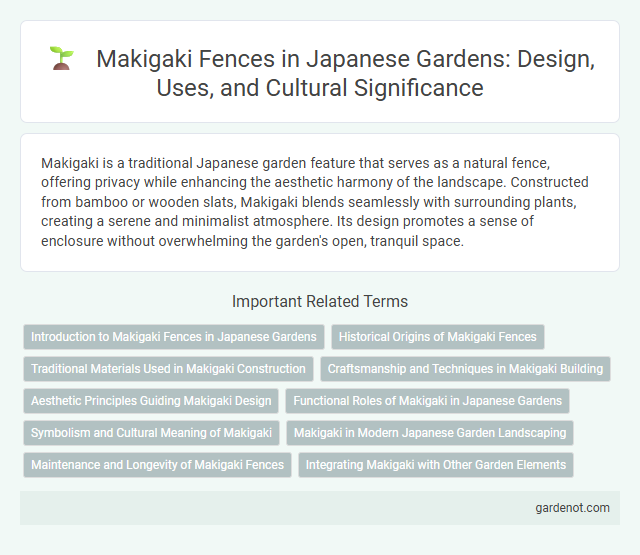Makigaki is a traditional Japanese garden feature that serves as a natural fence, offering privacy while enhancing the aesthetic harmony of the landscape. Constructed from bamboo or wooden slats, Makigaki blends seamlessly with surrounding plants, creating a serene and minimalist atmosphere. Its design promotes a sense of enclosure without overwhelming the garden's open, tranquil space.
Introduction to Makigaki Fences in Japanese Gardens
Makigaki fences in Japanese gardens serve as traditional bamboo screen enclosures that provide privacy while enhancing aesthetic harmony within the landscape. Crafted from carefully arranged bamboo slats and supported by wooden posts, Makigaki fences embody both functionality and artistic elegance. These fences contribute to the serene ambiance of Japanese gardens by blending seamlessly with natural elements and symbolizing the principles of simplicity and balance.
Historical Origins of Makigaki Fences
Makigaki fences originated during Japan's Edo period as functional barriers crafted from bundled bamboo or wooden slats, serving to enclose gardens and create privacy. These fences symbolize simplicity and natural beauty, embodying the wabi-sabi aesthetic central to traditional Japanese garden design. Their construction techniques reflect centuries-old craftsmanship aimed at harmonizing with the surrounding landscape while providing subtle boundaries.
Traditional Materials Used in Makigaki Construction
Makigaki, traditional Japanese woven fences, are crafted primarily from natural materials such as bamboo, reed, and wood, chosen for their durability and aesthetic harmony with garden surroundings. Bamboo poles are split and woven together, often anchored with natural fiber cords like hemp or jute to maintain flexibility and strength. These materials not only reflect centuries of Japanese craftsmanship but also promote sustainability and integration with the natural environment in garden design.
Craftsmanship and Techniques in Makigaki Building
Makigaki construction showcases exceptional craftsmanship through precise bamboo selection and intricate weaving techniques that ensure durability and aesthetic harmony. Artisans employ traditional knotting methods and tension adjustments to create structurally sound fences that blend seamlessly with natural garden landscapes. Mastery in balancing functional strength with delicate design elements exemplifies the refined skills integral to authentic Makigaki building.
Aesthetic Principles Guiding Makigaki Design
Makigaki design in Japanese gardens embodies wabi-sabi, emphasizing simplicity, imperfection, and natural beauty in bamboo fence structures. The aesthetic principles prioritize harmony with the surrounding environment, using asymmetry and textured materials to create a sense of balance and tranquility. This approach enhances the garden's contemplative atmosphere by subtly blending functionality with artistic expression.
Functional Roles of Makigaki in Japanese Gardens
Makigaki, traditional rolled bamboo fences, serve as essential elements in Japanese gardens by delineating spaces and creating a sense of privacy without obstructing natural views. These fences function to guide visitors along specific pathways while harmonizing with the garden's aesthetics and reinforcing seasonal transitions through their organic materials. Their lightweight, porous structure also facilitates airflow, contributing to the garden's balanced environment and promoting a feeling of tranquility and enclosure.
Symbolism and Cultural Meaning of Makigaki
Makigaki, a traditional Japanese woven bamboo fence, symbolizes protection and boundary within garden spaces while reflecting simplicity and natural beauty integral to Japanese aesthetics. Its construction embodies the harmony between human craftsmanship and nature, representing respect for natural materials and seasonal changes. In cultural contexts, Makigaki serves as a subtle divider that enhances the garden's spiritual tranquility and invites contemplation.
Makigaki in Modern Japanese Garden Landscaping
Makigaki, traditional bamboo fences, play a crucial role in modern Japanese garden landscaping by blending cultural heritage with contemporary design principles. These fences provide both privacy and aesthetic appeal, creating natural boundaries that enhance the garden's tranquility and harmony. Incorporating Makigaki can elevate the spatial organization and visual rhythm in urban green spaces, emphasizing sustainability and craftsmanship.
Maintenance and Longevity of Makigaki Fences
Makigaki fences require regular maintenance, including cleaning to remove moss and debris, and periodic reapplication of traditional natural preservatives like tung oil to prevent weathering. Proper pruning of nearby plants and ensuring good drainage around the base help minimize moisture damage and extend the fence's lifespan. With consistent care, Makigaki fences can remain structurally sound and visually appealing for several decades, preserving the authentic aesthetic of Japanese gardens.
Integrating Makigaki with Other Garden Elements
Makigaki, traditional bamboo fences, seamlessly blend with stone lanterns, water features, and moss beds to create harmonious visual and tactile contrasts in Japanese gardens. Their natural texture complements the organic shapes of surrounding plants while defining pathways and framing scenic views. Integrating Makigaki enhances spatial layering and contributes to the garden's subtle balance of privacy and openness.
Makigaki Infographic

 gardenot.com
gardenot.com